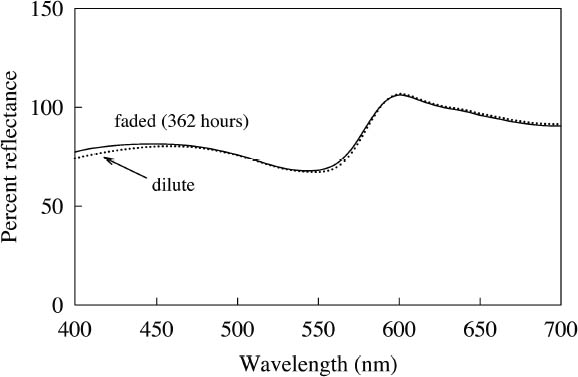EVALUATION OF APPEARANCE AND FADING OF DAYLIGHT FLUORESCENT WATERCOLORSSANDRA A. CONNORS-ROWE, HANNAH R. MORRIS, & PAUL M. WHITMORE
4 CONSERVATION ISSUES4.1 COLOR COMPENSATION FOR FLUORESCENT PAINTSThe presence of fluorescent colors on a work of art poses some difficult restoration problems. Foremost among them is matching the luminosity and high chroma that are essential to fluorescent appearance when inpainting damaged areas. Six of the 12 watercolors—Fuchsia, Raspberry, Sunrise Pink, Tahiti Red, Ice Pink, and Tropic Pink—retain their fluorescent character throughout the fading process (see fig. 7). This finding is evident from the reflectance for each of these watercolors, which remains higher than the reflectance of the white paper alone (approximately 80%). It would be impossible to achieve even a metameric match to these colors using a nonfluorescent colorant. One could consider using paints that are identical to the paint on the original artwork to match the fluorescent appearance. For this strategy to be feasible, the retouching paint must match the appearance of a color that has already suffered some fading from light exposure. To see if a fluorescent watercolor could be used to match itself in a faded state, a range of colors were produced from dilutions of each watercolor. These colors were measured and compared to colors produced during fading. Figure 10 shows the spectra for both diluted and faded Tropic Pink. This reasonably good spectral match (ΔE = 0.65) is maintained through all applications of the color from high to low concentrations. This result is typical for the six watercolors mentioned above—Fuchsia, Raspberry, Sunrise Pink, Tahiti Red, Ice Pink, and Tropic Pink. Thus, the original
The final six watercolors—Ice Yellow, Tropic Gold, Sunset Orange, Sunset Red, Ice Green, and Sunshine Yellow—all have more complex fading behavior under daylight exposure (see fig. 7). All show complex spectral changes after short exposure times (approximately 24 hours), and some display significant shifts in hue as a result. Since such spectral shifts occur during fading, one might expect that color matching with the original unfaded colorant would be difficult. To assess whether color matches to these faded paints are feasible, the colors produced from dilutions of these six watercolors were measured and compared to their faded counterparts. The colors seem to match reasonably well when the concentration of color is high (i.e., only slightly faded). However, after more extensive fading, the diluted color is no longer able to match the faded appearance. It is apparent from the data shown in figure 7 that these watercolors lose their fluorescent character—luminosity and high chroma—during fading. As a result, nonfluorescent paints may be better choices for color compensation for these very degraded fluorescent paints. 4.2 INFERRING ORIGINAL APPEARANCEConservators and curators frequently strive to understand and present the original appearance of a work of art. The choice of lighting is often a critical factor in how a picture is perceived. For works containing fluorescent watercolors, that choice is particularly crucial because the degree of fluorescent appearance (chroma and luminosity) of these materials can be altered substantially depending on the choice of lighting environment. Aging of works containing fluorescent watercolors poses a different challenge in assessing the original appearance of a painting, for it is sometimes difficult to determine whether a fluorescent color was originally present. Some information about condition and possible alteration of the watercolors in this study can be gained from visual inspection. When viewed in daylight, faded areas of these colors appear mottled and dull. It is unlikely that one would confuse such faded areas with dilute applications (low color concentration) of the same watercolor, and one might in fact mistake such passages as applications of nonfluorescent paint. It can be confirmed that these colors are fluorescent by viewing them under black light. Significantly faded watercolors still appear to weakly fluoresce when exposed to ultraviolet radiation, even if they no longer appear remarkably luminous under daylight illumination. This weak fluorescent emission under black light illumination from obviously faded watercolor areas may indicate an original appearance of the watercolor that was darker and more fluorescent than its current appearance. After extensive fading, several of these watercolors—Ice Yellow, Tropic Gold, Sunset Orange, Sunset Red, Ice Green, and Sunshine Yellow— become indistinguishable from one another, all appearing dull yellow-brown in color. In this case it would be impossible by simple inspection to determine both the original depth of shade and the hue of the original color. Visual inspection of these watercolors becomes more difficult when viewed under black light. Under these conditions one observes only the fluorescent emission, and the visual cues that distinguish these colors as faded (mottled and dull appearance) are not visible. Unfortunately, without these visual cues or without some knowledge of the color's original appearance and fluorescent intensity, it is difficult |
